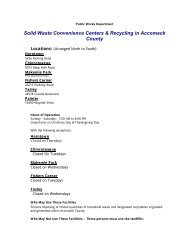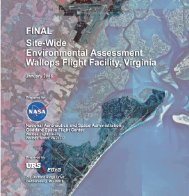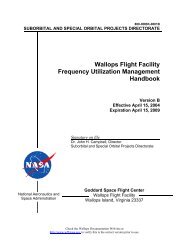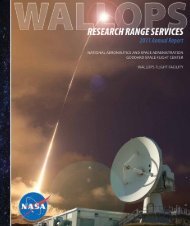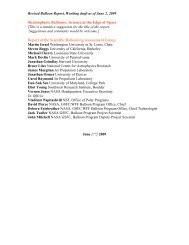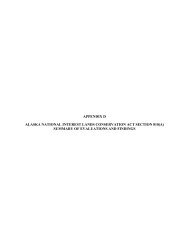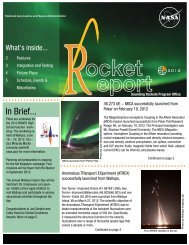Alternative Energy Draft EA - NASA Visitor Center at Wallops Flight ...
Alternative Energy Draft EA - NASA Visitor Center at Wallops Flight ...
Alternative Energy Draft EA - NASA Visitor Center at Wallops Flight ...
Create successful ePaper yourself
Turn your PDF publications into a flip-book with our unique Google optimized e-Paper software.
SECTION FIVE: MITIGATION AND MONITORING<br />
5.1 MITIGATION<br />
Mitig<strong>at</strong>ion and Monitoring<br />
CEQ regul<strong>at</strong>ions (40 CFR 1508.20) define mitig<strong>at</strong>ion to include: (1) avoiding the impact<br />
altogether by not taking a certain action or parts of an action; (2) minimizing impacts by limiting<br />
the degree or magnitude of the action and its implement<strong>at</strong>ion; (3) rectifying the impact by<br />
repairing, rehabilit<strong>at</strong>ing, or restoring the affected environment; (4) reducing or elimin<strong>at</strong>ing the<br />
impact over time by preserv<strong>at</strong>ion and maintenance oper<strong>at</strong>ions during the lifetime of the action;<br />
and (5) compens<strong>at</strong>ing for the impact by replacing or providing substitute resources or<br />
environments. Described below are <strong>NASA</strong>’s proposed mitig<strong>at</strong>ion measures for wind turbines<br />
under the WFF <strong>Altern<strong>at</strong>ive</strong> <strong>Energy</strong> Project. Mitig<strong>at</strong>ion measures are described by resource area.<br />
5.1.1 Wetlands<br />
Up to 0.36 hectare (0.88 acre) of wetlands would be filled under the Proposed Action; 0.29<br />
hectare (0.71 acre) of estuarine intertidal emergent wetlands, 0.06 hectare (0.14 acre) of<br />
palustrine emergent wetlands, and 0.01 hectare (0.03 acre) of palustrine scrub-shrub wetlands.<br />
The potentially affected wetlands are considered jurisdictional under Section 404 of the CWA<br />
and are regul<strong>at</strong>ed by the USACE, VDEQ, and Accomack County Wetlands Board. Prior to<br />
construction, <strong>NASA</strong> would notify the public and coordin<strong>at</strong>e with applicable agencies including<br />
USACE, the VDEQ, VMRC, and the Accomack County Wetlands Board; these agencies would<br />
be notified of potential impacts on wetlands by VMRC through the JPA process. <strong>NASA</strong> would<br />
obtain necessary permits including CWA Section 404, Section 10, and Section 401 W<strong>at</strong>er<br />
Quality Certific<strong>at</strong>ion/Virginia W<strong>at</strong>er Protection permits and accordingly would implement a<br />
minimum of 0.362 hectare (0.895 acre) of wetland compens<strong>at</strong>ion <strong>at</strong> the Mainland (Figure 18).<br />
5.1.2 Birds and B<strong>at</strong>s<br />
The Federal Avi<strong>at</strong>ion Administr<strong>at</strong>ion (FAA) requires th<strong>at</strong> any structure taller than 61 meters (200<br />
feet) above ground level must have aircraft warning lights. Gehring, et. al. (2009) found th<strong>at</strong> the<br />
use of red or white flashing obstruction lights strongly correl<strong>at</strong>ed with a decrease in avian<br />
f<strong>at</strong>alities compared to non-flashing, steady burning lights <strong>at</strong> tower systems. Gehring, et. al.<br />
further st<strong>at</strong>ed th<strong>at</strong> “Removing non-flashing lights from towers is one of the most effective and<br />
economically feasible means of achieving a significant reduction in avian f<strong>at</strong>alities <strong>at</strong> existing<br />
communic<strong>at</strong>ion towers.” Because the proposed wind turbines would be taller than 61 meters (200<br />
feet), <strong>NASA</strong> would utilize either red or white flashing light systems.<br />
Numerous technologies and methodologies (e.g., blade color p<strong>at</strong>terns, flight diverters, acoustic<br />
deterrents, etc.) are currently under development to lessen the potential risk th<strong>at</strong> wind turbines<br />
pose to avifauna. <strong>NASA</strong> may consider implementing such technologies to both test their efficacy<br />
and to reduce potential impacts.<br />
5.2 MONITORING<br />
Under NEPA, a Federal agency has a continuing duty to g<strong>at</strong>her and evalu<strong>at</strong>e new inform<strong>at</strong>ion<br />
relevant to the environmental impact of its actions. Below is a summary of <strong>NASA</strong>’s proposed<br />
monitoring plan for the implement<strong>at</strong>ion of the two utility-scale wind turbines on <strong>Wallops</strong> Island.<br />
The focus of the monitoring plans would be to track the effects of the project on birds and b<strong>at</strong>s.<br />
149




